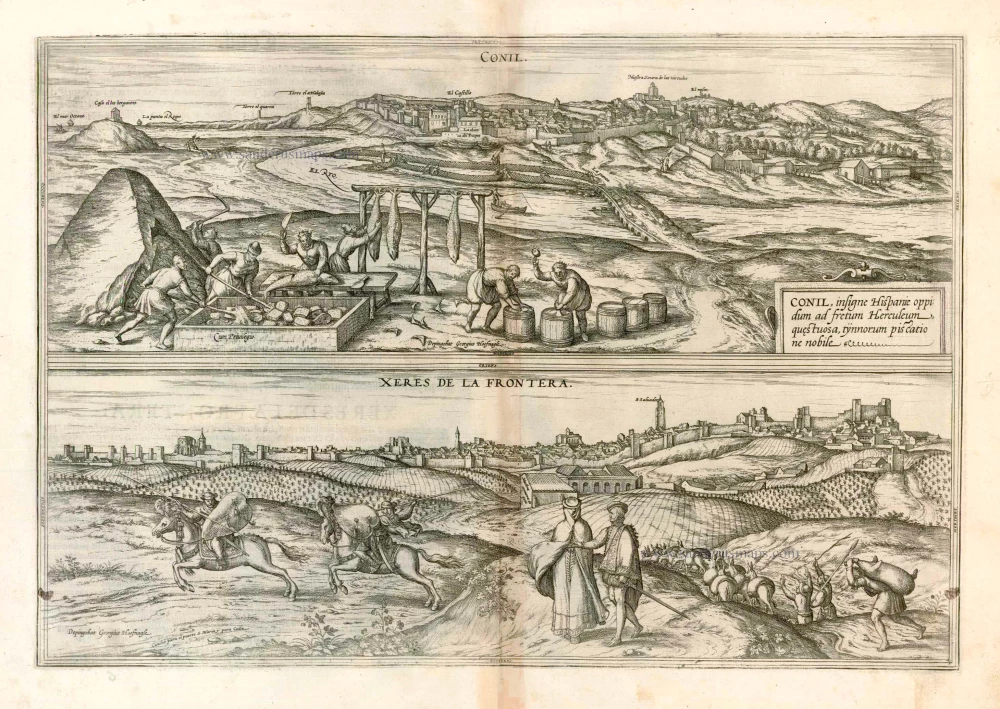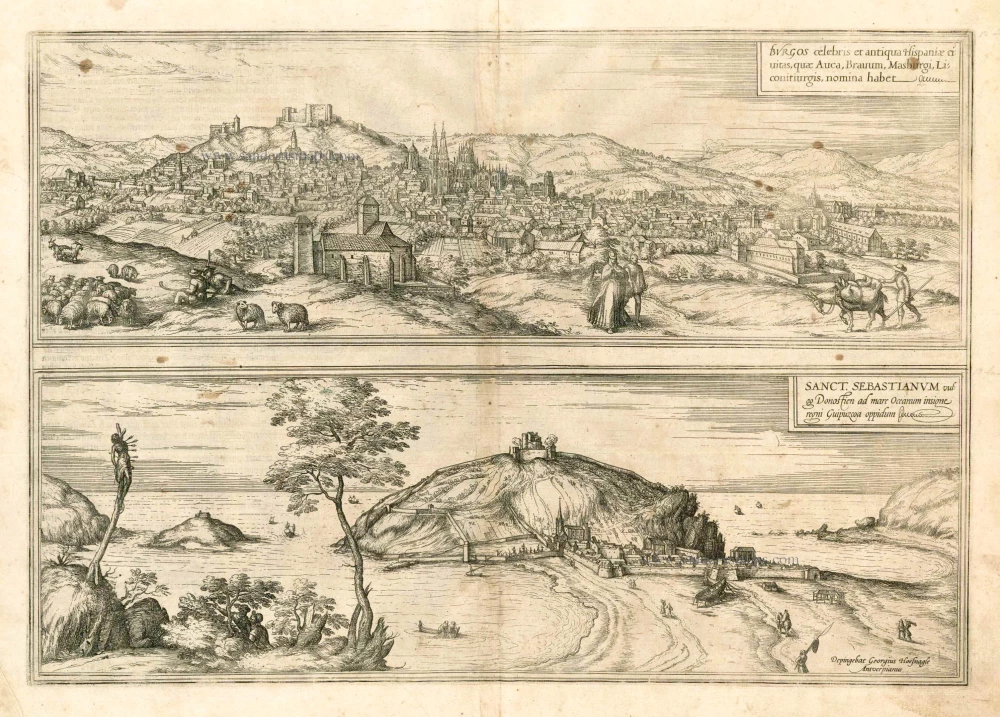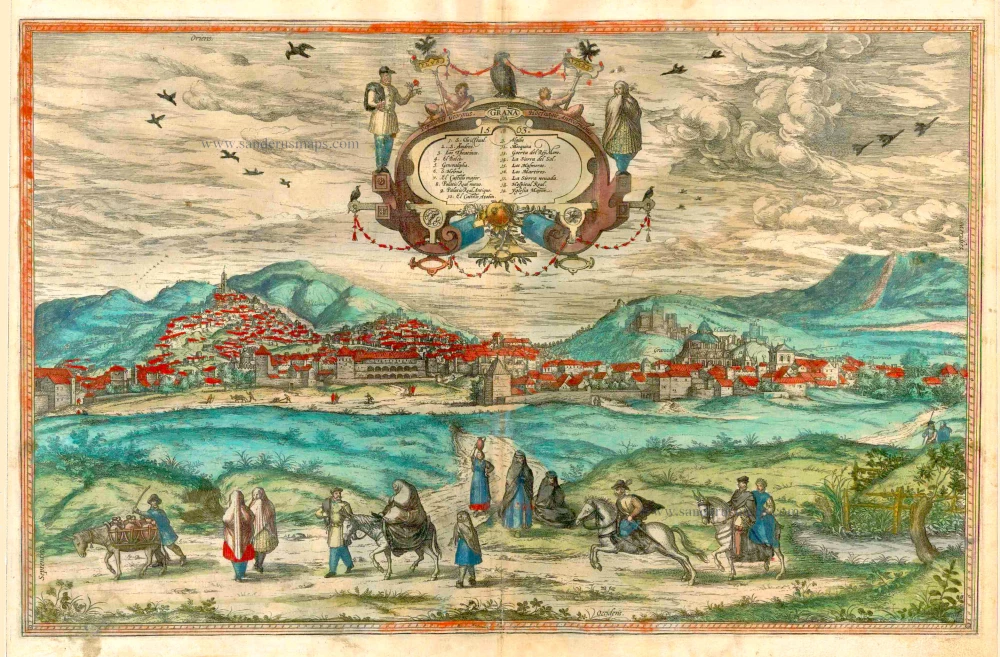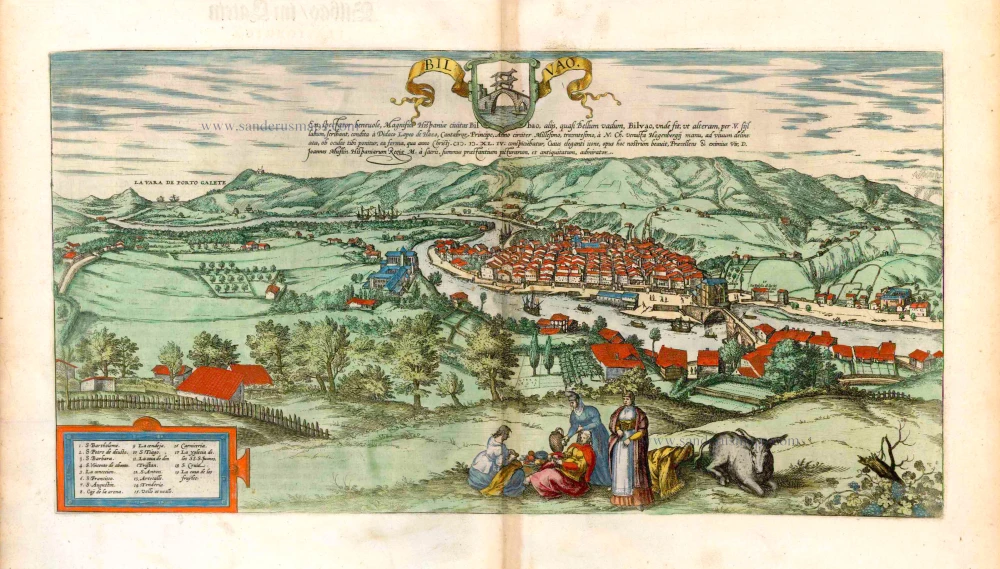Bornes and Zahara, by Georg Braun and Frans Hogenberg. 1596
BORNOS
COMMENTARY BY BRAUN: "Andalusia is distinguished by famous cities, of which we have described a considerable number. While on the road to Malaga, we also drew this little town because of its particular situation. Bornos lies in a fertile region, which offers good gardens and hunting opportunities for the nobility and others. Contrasting with this is the very high, bleak and infertile mountain behind, which makes the fields and pastures of Bornos seem all the more fertile".
The Andalusian town of Bornos, situated on the Guadalete on the eastern slopes of the Sierra del Calvario near Arcos de la Frontera, can look back over an eventful history. The first humans settled here 30,000 years ago, followed by the Iberians and the Romans. Bornos saw a flowering under the Moors as a fortified town in the Fontanar region; the Castillo Palacio de los Ribera - the former Moorish Castillo del Fontanar - can still be visited today. In the 13th century, Bornos was taken by Christian troops.
ZAHARA DE LA SIERRA
COMMENTARY BY BRAUN: "Zahara's unique location has prompted Hoefnagel to present the small town and the castle from both sides. The castle sits on top of a high rock, built in primaeval times and with a rich history during the Granada War. During the period in which the Christian princes in Spain were occupied with the Portuguese War, they had an agreement with the Moors for a certain time. In the meantime, however, Zahara has been recovered from the Moors on account of the diplomacy and the experience of the Margrave of Cadiz and placed back at the disposal of the Christians."
The fortress, once considered impregnable, is presented in a picturesque setting with two views - on the left from the southeast and on the right from the north. It lies on a sheer rock and dominates the Guadalete Valley. The Arabs founded Zahara de la Sierra in the 8th century. In Moorish times, the town, which consisted primarily of white buildings (a fact of which the person who coloured the engraving was unaware), was an important station on the road to Granada. The Christians succeeded in taking Zahara in 1483. The ruins and the square keep of the 12th-century Moorish fortress can still be seen today.
Braun G. & Hogenberg F. and the Civitates Orbis Terrarum.
The Civitates Orbis Terrarum, also known as the 'Braun & Hogenberg', is a six-volume town atlas and the most excellent book of town views and plans ever published: 363 engravings, sometimes beautifully coloured. It was one of the best-selling works in the last quarter of the 16th century. Georg Braun, a skilled writer, wrote the text accompanying the plans and views on the verso. Many plates were engraved after the original drawings of a professional artist, Joris Hoefnagel (1542-1600). The first volume was published in Latin in 1572 and the sixth in 1617. Frans Hogenberg, a talented engraver, created the tables for volumes I through IV, and Simon van den Neuwel made those for volumes V and VI. Other contributors were cartographers Daniel Freese and Heinrich Rantzau, who provided valuable geographical information. Works by Jacob van Deventer, Sebastian Münster, and Johannes Stumpf were also used as references. Translations appeared in German and French, making the atlas accessible to a broader audience.
Since its original publication of volume 1 in 1572, the Civitates Orbis Terrarum has left an indelible mark on the history of cartography. Seven more editions followed the first volume in 1575, 1577, 1582, 1588, 1593, 1599, and 1612. Vol.2, initially released in 1575, saw subsequent editions in 1597 and 1612. The subsequent volumes, each a treasure trove of historical insights, graced the world in 1581, 1588, 1593, 1599, and 1606. The German translation of the first volume, a testament to its widespread appeal, debuted in 1574, followed by the French edition in 1575.
Several printers were involved: Theodor Graminaeus, Heinrich von Aich, Gottfried von Kempen, Johannis Sinniger, Bertram Buchholtz, and Peter von Brachel, all of whom worked in Cologne.
Georg Braun (1541-1622)
Georg Braun, the author of the text accompanying the plans and views in the Civitates Orbis Terrarum, was born in Cologne in 1541. After his studies in Cologne, he entered the Jesuit Order as a novice, indicating his commitment to learning and intellectual pursuits. In 1561, he obtained his bachelor's degree; in 1562, he received his Magister Artium, further demonstrating his academic achievements. Although he left the Jesuit Order, he continued his studies in theology, gaining a licentiate in theology. His theological background likely influenced the content and tone of the text in the Civitates Orbis Terrarum, adding a unique perspective to the work.
Frans Hogenberg (1535-1590)
Frans Hogenberg was a Flemish and German painter, engraver, and mapmaker. He was born in Mechelen as the son of Nicolaas Hogenberg.
By the end of the 1560s, Frans Hogenberg was employed upon Abraham Ortelius's Theatrum Orbis Terrarum, published in 1570; he is named an engraver of numerous maps. In 1568, he was banned from Antwerp by the Duke of Alva and travelled to London, where he stayed a few years before emigrating to Cologne. He immediately embarked on his two most important works, the Civitates, published in 1572 and the Geschichtsblätter, which appeared in several series from 1569 until about 1587.
Thanks to large-scale projects like the Geschichtsblätter and the Civitates, Hogenberg's social circumstances improved with each passing year. He died as a wealthy man in Cologne in 1590.
Bornnes [on sheet with] Zahara
Item Number: 24143 Authenticity Guarantee
Category: Antique maps > Europe > Spain and Portugal
Old, antique map with three bird's-eye views by Braun and Hogenberg: one of Bornes and two of Zahara, after G. Hoefnagel.
Title: Bornnes [on sheet with] Zahara
Date of the first edition: 1596.
Date of this map: 1596.
Date on map: 1564.
Copper engraving, printed on paper.
Size (not including margins): 350 x 478mm (13.78 x 18.82 inches).
Verso: Latin text.
Condition: Uncoloured, excellent.
Condition Rating: A.
From: Urbium Praecipuarum Mundi Theatrum Quintum Auctore Georgio Braunio Agrippinate. Part 5. Köln, 1596/97. (Van der Krogt 4, 41:1.5)
BORNOS
COMMENTARY BY BRAUN: "Andalusia is distinguished by famous cities, of which we have described a considerable number. While on the road to Malaga, we also drew this little town because of its particular situation. Bornos lies in a fertile region, which offers good gardens and hunting opportunities for the nobility and others. Contrasting with this is the very high, bleak and infertile mountain behind, which makes the fields and pastures of Bornos seem all the more fertile".
The Andalusian town of Bornos, situated on the Guadalete on the eastern slopes of the Sierra del Calvario near Arcos de la Frontera, can look back over an eventful history. The first humans settled here 30,000 years ago, followed by the Iberians and the Romans. Bornos saw a flowering under the Moors as a fortified town in the Fontanar region; the Castillo Palacio de los Ribera - the former Moorish Castillo del Fontanar - can still be visited today. In the 13th century, Bornos was taken by Christian troops.
ZAHARA DE LA SIERRA
COMMENTARY BY BRAUN: "Zahara's unique location has prompted Hoefnagel to present the small town and the castle from both sides. The castle sits on top of a high rock, built in primaeval times and with a rich history during the Granada War. During the period in which the Christian princes in Spain were occupied with the Portuguese War, they had an agreement with the Moors for a certain time. In the meantime, however, Zahara has been recovered from the Moors on account of the diplomacy and the experience of the Margrave of Cadiz and placed back at the disposal of the Christians."
The fortress, once considered impregnable, is presented in a picturesque setting with two views - on the left from the southeast and on the right from the north. It lies on a sheer rock and dominates the Guadalete Valley. The Arabs founded Zahara de la Sierra in the 8th century. In Moorish times, the town, which consisted primarily of white buildings (a fact of which the person who coloured the engraving was unaware), was an important station on the road to Granada. The Christians succeeded in taking Zahara in 1483. The ruins and the square keep of the 12th-century Moorish fortress can still be seen today.
Braun G. & Hogenberg F. and the Civitates Orbis Terrarum.
The Civitates Orbis Terrarum, also known as the 'Braun & Hogenberg', is a six-volume town atlas and the most excellent book of town views and plans ever published: 363 engravings, sometimes beautifully coloured. It was one of the best-selling works in the last quarter of the 16th century. Georg Braun, a skilled writer, wrote the text accompanying the plans and views on the verso. Many plates were engraved after the original drawings of a professional artist, Joris Hoefnagel (1542-1600). The first volume was published in Latin in 1572 and the sixth in 1617. Frans Hogenberg, a talented engraver, created the tables for volumes I through IV, and Simon van den Neuwel made those for volumes V and VI. Other contributors were cartographers Daniel Freese and Heinrich Rantzau, who provided valuable geographical information. Works by Jacob van Deventer, Sebastian Münster, and Johannes Stumpf were also used as references. Translations appeared in German and French, making the atlas accessible to a broader audience.
Since its original publication of volume 1 in 1572, the Civitates Orbis Terrarum has left an indelible mark on the history of cartography. Seven more editions followed the first volume in 1575, 1577, 1582, 1588, 1593, 1599, and 1612. Vol.2, initially released in 1575, saw subsequent editions in 1597 and 1612. The subsequent volumes, each a treasure trove of historical insights, graced the world in 1581, 1588, 1593, 1599, and 1606. The German translation of the first volume, a testament to its widespread appeal, debuted in 1574, followed by the French edition in 1575.
Several printers were involved: Theodor Graminaeus, Heinrich von Aich, Gottfried von Kempen, Johannis Sinniger, Bertram Buchholtz, and Peter von Brachel, all of whom worked in Cologne.
Georg Braun (1541-1622)
Georg Braun, the author of the text accompanying the plans and views in the Civitates Orbis Terrarum, was born in Cologne in 1541. After his studies in Cologne, he entered the Jesuit Order as a novice, indicating his commitment to learning and intellectual pursuits. In 1561, he obtained his bachelor's degree; in 1562, he received his Magister Artium, further demonstrating his academic achievements. Although he left the Jesuit Order, he continued his studies in theology, gaining a licentiate in theology. His theological background likely influenced the content and tone of the text in the Civitates Orbis Terrarum, adding a unique perspective to the work.
Frans Hogenberg (1535-1590)
Frans Hogenberg was a Flemish and German painter, engraver, and mapmaker. He was born in Mechelen as the son of Nicolaas Hogenberg.
By the end of the 1560s, Frans Hogenberg was employed upon Abraham Ortelius's Theatrum Orbis Terrarum, published in 1570; he is named an engraver of numerous maps. In 1568, he was banned from Antwerp by the Duke of Alva and travelled to London, where he stayed a few years before emigrating to Cologne. He immediately embarked on his two most important works, the Civitates, published in 1572 and the Geschichtsblätter, which appeared in several series from 1569 until about 1587.
Thanks to large-scale projects like the Geschichtsblätter and the Civitates, Hogenberg's social circumstances improved with each passing year. He died as a wealthy man in Cologne in 1590.





